
Lowriders are a staple of pop culture, from movies to magazines to professional wrestling. Undoubtedly, these cars catch people's attention at as their bright metal bodies cruise down the streets and jump at the press of a button. And for Latinos specifically, they hold a special place. this.
Lowriders are often associated with Chicanos, a term for those of Mexican descent who live in the United States. The term became popular, along with lowriders, in the 1940s as Chicanos forged an identity for themselves in the U.S. through a series of movements.
John Ulloa, a professor of cultural anthropology at Skyline College, says that the origin of lowriders is highly debated. Still, most people accept that modern-day lowriding culture began with the Zoot Suit movement in the 1940s.
The Zoot Suit movement was an anti-war statement from Mexican-American youth in the Southwest U.S. As a way to oppose the Second World War, they designed and dressed in baggy suits made from excess fabric, something that was seen as unpatriotic by Americans due to wartime rationing of fabric. According to Ulloa, Zoot Suitors also began modifying their cars in opposition to the mainstream car culture of the time.
"Chicanos developed lowriding by rolling their cars in the opposite stance of what Anglo car enthusiasts were doing, which was the California Rake," said Ulloa.
California Rake was an American car movement where people modified their cars for speed, which included dropping the front end of their vehicles to reduce drag. Lowriders initially did the complete opposite, raising the backs of their cars and driving low and slow.
"Lowriding certainly was making a statement; this is who we are, and this is what we're about," said Ulloa.

Originally, Chicanos resorted to cutting the springs on their vehicles to get them lower to the ground. However, they later added hydraulic systems to raise and lower them after police targeted lowriders. According to Ulloa, the hydraulics helped Chicanos avoid getting ticketed by police.
"Lowriders actually put hydraulics on the car in order to get around the cops," said Ulloa. "If they saw a cop, they would raise the car up and not get a ticket."
Lowriding began as a form of resistance to American culture, but it also showcased how resourceful Latinos were at a time when they had less economic and social prosperity in the U.S.
According to Ulloa, some of the first lowriding clubs were formed by people who would buy broken cars and sell them after repairing them. In fact, that is how the Dukes Car Club, the oldest lowrider club, got started. The Ruelas brothers, who started the club, often accompanied their uncle to LA junkyards to find old cars, engines and spare parts to repair.
"Lowriding in its inception was a blue-collar thing. It wasn't like it is now where you have all kinds of people with money," said Ulloa. "Cars were big back then, and they were cheap. People were building cars in the backyards and garages for practically nothing."
Since the height of lowriding culture in the 70s and 80s, Ulloa says that lowriding has grown and changed. Lowriding has grown out of the Hispanic neighborhoods and is now even found in Hawaii and Japan. There is also a lot more money involved in lowriding now, as prices for cars and parts have skyrocketed due to its popularity.
"It's very interesting to see that what began as a very small culture regulated to the barrios has now become a cultural phenomenon and beyond," said Ulloa.
© 2025 Latin Times. All rights reserved. Do not reproduce without permission.





